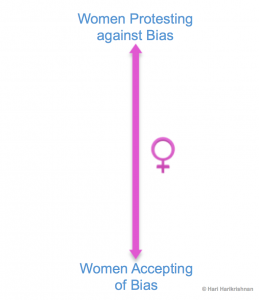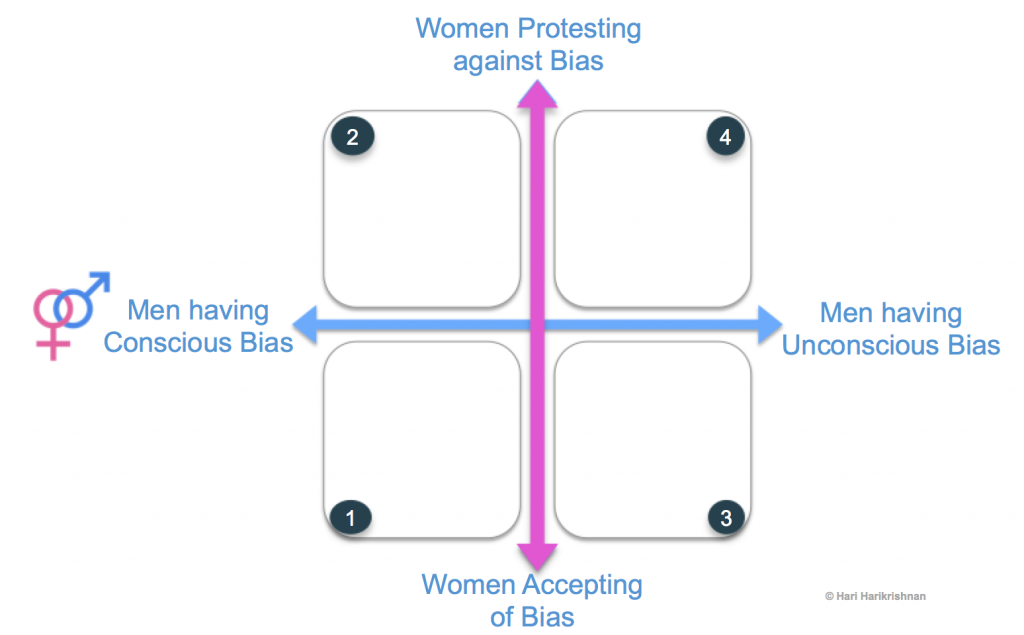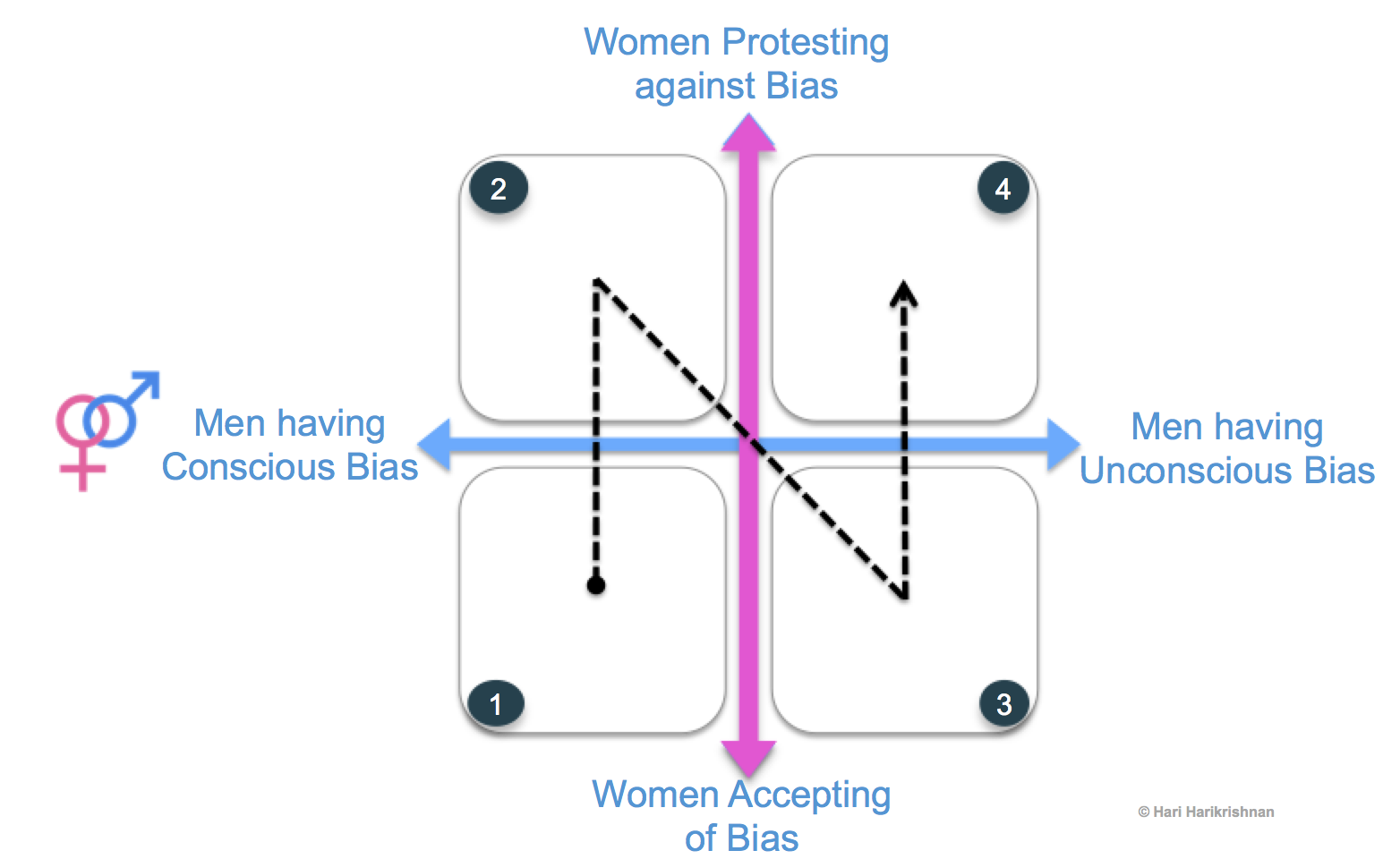Last week we celebrated the International Women’s Day. We cheered, we lamented, we measured progress, or the lack of it. A friend quipped on whatsapp: “In 1816 women had no rights, in 1916 they had some rights, in 2016 they are always right”. On a long flight from San Francisco to Istanbul, I reflected on how gender equality has evolved over centuries, by matching the attitudes of men and women towards bias.
Mapping Bias
I started by placing men’s attitudes on a spectrum ranging from conscious bias to unconscious bias as below.

Then I placed women’s attitudes on a spectrum ranging from accepting bias to protesting bias.

To see how women responded to men’s bias, I placed these axes together.

Time was when women accepted men’s overt bias, as in quadrant 1. Time is now when women protest against men’s unconscious bias, as in quadrant 4. In between lie times where women protested against conscious bias or accepted unconscious bias. The plot over time looks like this.

If you follow my friend’s quip above through this map, it will be as if 1816 is quadrant 2; 1916 in quadrant 3; 2016 in quadrant 4…just labels to mark time. The path blazed over centuries makes for an ominous shape – an ’N’ that seems to scream ‘no’? I think of it as the N-continuum of gender inequality.
The N-continuum is beyond simple evolution. It actually represents real progress over hundreds of years. Varied statistics from child marriage, to years of education, to health and wealth, the numbers have improved. We have world leaders who are women. But the numbers also suggest we have a long way to go. So we can’t simply be contented about the status quo. Social and economic progress such as community health and global productivity depend on continued progression towards gender equality.
The N-continuum made me wonder about how we went from a terrible state like quadrant 1 to quadrant 2. How did we arrive there? What part did men of influence play a role in the arrival or departure from that quadrant? That’s a topic for another time.
Three Iconic Women
Bulk of the women’s rights activists and women of accomplishment fall in to quadrant 2 in the last century or quadrant 4 in this century. While we all have women we know in our circles who come to mind for having overcome bias in their own ways, three personas come to mind when I think of gender bias. This is not to ignore the numerous others, but these have special appeal to me. You won’t see them being celebrated at your local women’s action forums. These three are from different eras, from different geographies, and from different races. They represent slices of time in the N-continuum of gender inequality.
![]()
- Nangeli: In early 1900s, Nangeli protested against the oppressive upper caste landlords in Kerala, India. The upper caste ruled that lower caste women must pay taxes to have the right to cover their breasts. Nangeli protested, by cutting off her breasts. Her courage and defiance leaves you dead on your tracks, doesn’t it?
- Sister Rosetta Tharpe: The Godmother of Rock and Roll, who gave voice to many male musicians like Chuck Berry and Johnny Cash. Her singing of This Train in the 1930s is like Nina Simone singing Mississippi Goddamn in the 1960s. A voiced protest. A black woman playing an electric guitar in the 1950s is an image to behold.
- Eugénie Brazier: Also known as La Mère Brazier, she is a renowned chef from the 1920s, first winner of 6 Michelin stars and one who gave rise to a lineage of renowned 20th century French chefs. The roadside restaurants of Mères (mothers) on the way from Lyon to Italy served travelers and put women to work in the wake of the Great War. Can’t tell if she protested, but she served. She served tasty meals at a time of conscious bias and need for brutal resolve to recover from a socio-economic disaster.
There are many such quadrant 2 stalwarts who moved the ball so that we could outlaw conscious bias and move to quadrant 3 or 4. Most women today are in quadrant 4, protesting unconscious bias, sitting on a platform where conscious bias is illegal or frowned upon in most developed nations.
Looking Ahead
What next for the N-continuum? Just like Iron Age swept through different parts of the world at different times, these transitions through the quadrants happen in different parts of the world at different times. That explains why snapshots of progress is different in Middle East to Africa to South Asia to the West. You could map each country on this continuum based on where the majority of its women are in their response to bias. Will information technology fundamentally change businesses and societies and close the gender inequality faster? Will a digital society with pervasive connectivity of people via mobile and relentless spotlight on inequalities through data help us focus efforts to reduce bias? Here is hoping that traversal through the N-continuum is swift for generations here and beyond.
Epilogue
So what has all this got to do with washing machines and goddesses? I came across this sculpture at the water fountain of a San Francisco area restaurant. It depicts what looks like a roman goddess emptying a washing machine.

Running water made possible by indoor plumbing freed women from hard chores in the 20th century, something I always thought of as a significant technological and social milestone. Home automation of the last century via washers and dryers took it a step further. Oddly, the intended incongruity in this art – ancient goddess with a modern tool performing a household chore – is reminiscent of the lean-in discussions and nouveaux feminist activism. It reflects the reality of the 21st century women’s lives where they are balancing new conveniences with old ways of life and old biases, conscious or unconscious.


There is a parameter that we need to focus on which is time. In our era of technology acceleration 5 years or less becomes the norm for change. We also need to greatly speed up gender equality.
Agree. It shouldn’t take centuries to bring about change in this era.
Wonderful post Hari! I had never heard about the poor woman who cut off her breasts in protest, but many modern analogies could be made to that (many women have given up good jobs in order to protest poor treatment). I entered the industry in 1984 – and we had not yet entered quadrant 4. We have made considerable progress since then. I can only hope that we will all live to see us transcend the quadrants to a time when no protest is necessary- but we are not there yet. Was wonderful working in your organization, where this WAS true – no protest was necessary!
Thanks for the note, Brenda. Well said on hoping to see us transcend the quadrants. And thanks for the compliment on how we worked together.
I enjoyed reading this Hari. It presented concepts about unconscious bias that I have not thought about before. Thanks for expanding my knowledge on this topic, especially on the 3 iconic women.
Thanks for the feedback, Tim.
Hari! Well done, I thoroughly enjoyed reading your perspective on unconscious bias. I must say I am not surprised that you came up with the N Continuum – I enjoyed your 3 examples of iconic women as well as the photo of the unique sculpture you shared. I will look forward to your next piece.
Thanks Tina. Appreciate the note.
Hello Hari,
I am seeking permission to use your photo of the goddess with the washing machine. I will of course acknowledge you! Please contact me if you wish to understand the context for me using your photo.
Thanks!
Thanks for asking Debra. Seeing this 3-years later. Sorry. Go ahead please. I’d love to know how you used it. thanks. Hari